细读Spring源码(六)---Spring源码设计架构
往期回顾:
-
细读Spring源码(一)---refresh()方法概览
-
细读Spring源码(二)---关于Spring中用到的设计模式
-
细读Spring源码(三)---深度剖析动态代理底层实现
-
细读Spring源码(四)---什么是IOC?
-
细读Spring源码(五)---AOP从实战到源码
今天早上又回顾了一下源码,总结出了下面的这张Spring设计思想图,其实网上有很多相关的图,我主要还是按照核心方法refesh的流程总结的,因为这也是Spring容器启动过程中初始化的核心,话不多说,直接上图: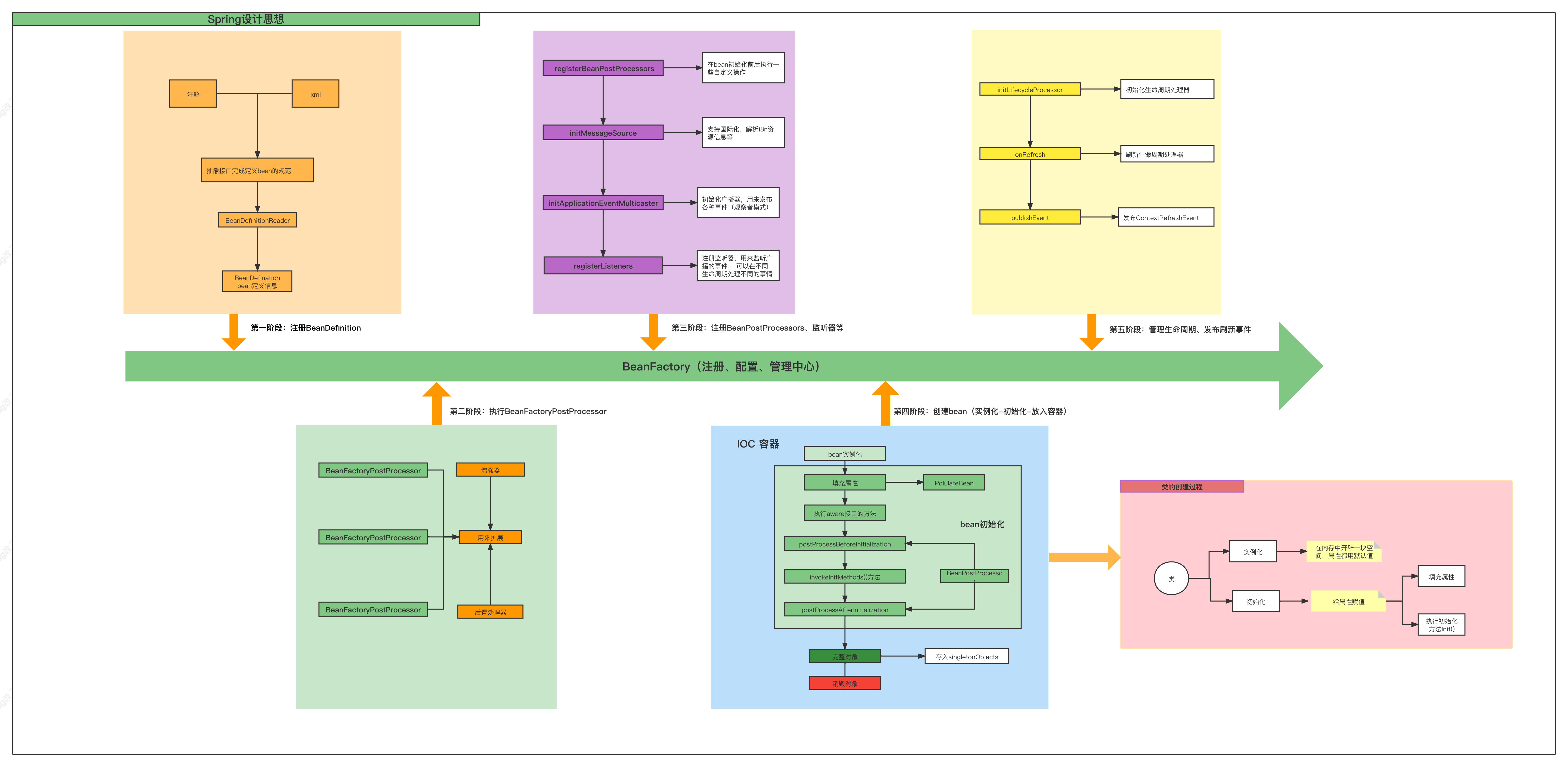
我将容器的启动过程粗略地分成了上面的五个阶段,首先可以看到从始至终都要与BeanFactory进行交互,所以先来看看BeanFactory这个接口:
在源码中是这样描述的:
1 /** 2 * The root interface for accessing a Spring bean container. 3 * 访问Spring bean容器的根接口 4 * 5 * <p>This is the basic client view of a bean container; 6 * further interfaces such as {@link ListableBeanFactory} and 7 * {@link org.springframework.beans.factory.config.ConfigurableBeanFactory} 8 * are available for specific purposes. 9 * BeanFactory是访问Spring bean容器的根接口,这是一个bean容器基本的客户端视图, 10 * 此外还有像ListableBeanFactory和ConfigurableBeanFactory这种为了特定目标使用的接口 11 * 12 * <p>This interface is implemented by objects that hold a number of bean definitions, 13 * each uniquely identified by a String name. Depending on the bean definition, 14 * the factory will return either an independent instance of a contained object 15 * (the Prototype design pattern), or a single shared instance (a superior 16 * alternative to the Singleton design pattern, in which the instance is a 17 * singleton in the scope of the factory). Which type of instance will be returned 18 * depends on the bean factory configuration: the API is the same. Since Spring 19 * 2.0, further scopes are available depending on the concrete application 20 * context (e.g. "request" and "session" scopes in a web environment). 21 * 该接口会被持有大量bean定义的对象实现,每一个都是通过一个字符串类型的name进行唯一标识。 22 * 根据bean的定义信息,工厂既可以返回一个已经存在对象的单独实例实例(原型设计模式),还可以返回一个能够被共享的单例实例(单例模式) 23 * 返回什么类型的实例,将依赖bean工厂中scope的配置:具有相同的API。从Spring2.0开始,可以根据具体的应用上下文使用其他的scope, 24 * 比如web应用中的request和session等 25 * 26 * <p>The point of this approach is that the BeanFactory is a central registry 27 * of application components, and centralizes configuration of application 28 * components (no more do individual objects need to read properties files, 29 * for example). See chapters 4 and 11 of "Expert One-on-One J2EE Design and 30 * Development" for a discussion of the benefits of this approach. 31 * 这种实现方式的精髓在于它让BeanFactory成为应用组件的注册和配置中心,比如单个对象将不再需要去读取属性文件 32 * 在《Expert One-on-One J2EE Design and Development》这本书的第4~11节就能讨论了该方法的优势 33 * 34 /
从上面注释中可以获取三点重要信息:
1、这是访问Spring容器的根接口
2、这个接口被维护BeanDefinition信息的接口所继承,提供了对bean定义信息的管理,通过该接口,可以返回单例或多例的bean实例
3、它就像一个应用组件的注册和配置中心,集中管理容器中的bean,而不需要为了某个单独的bean单独读取配置文件
下面这种图中右边部分是该接口中的所有方法,左边注释部分说明实现该接口的工厂必须尽可能地支持标准bean生命周期的接口,同时给出了全部的初始化方法和它们的标准执行顺序,其实主要就是在实例化前后执行的BeanPostProcessor及它们的执行顺序。
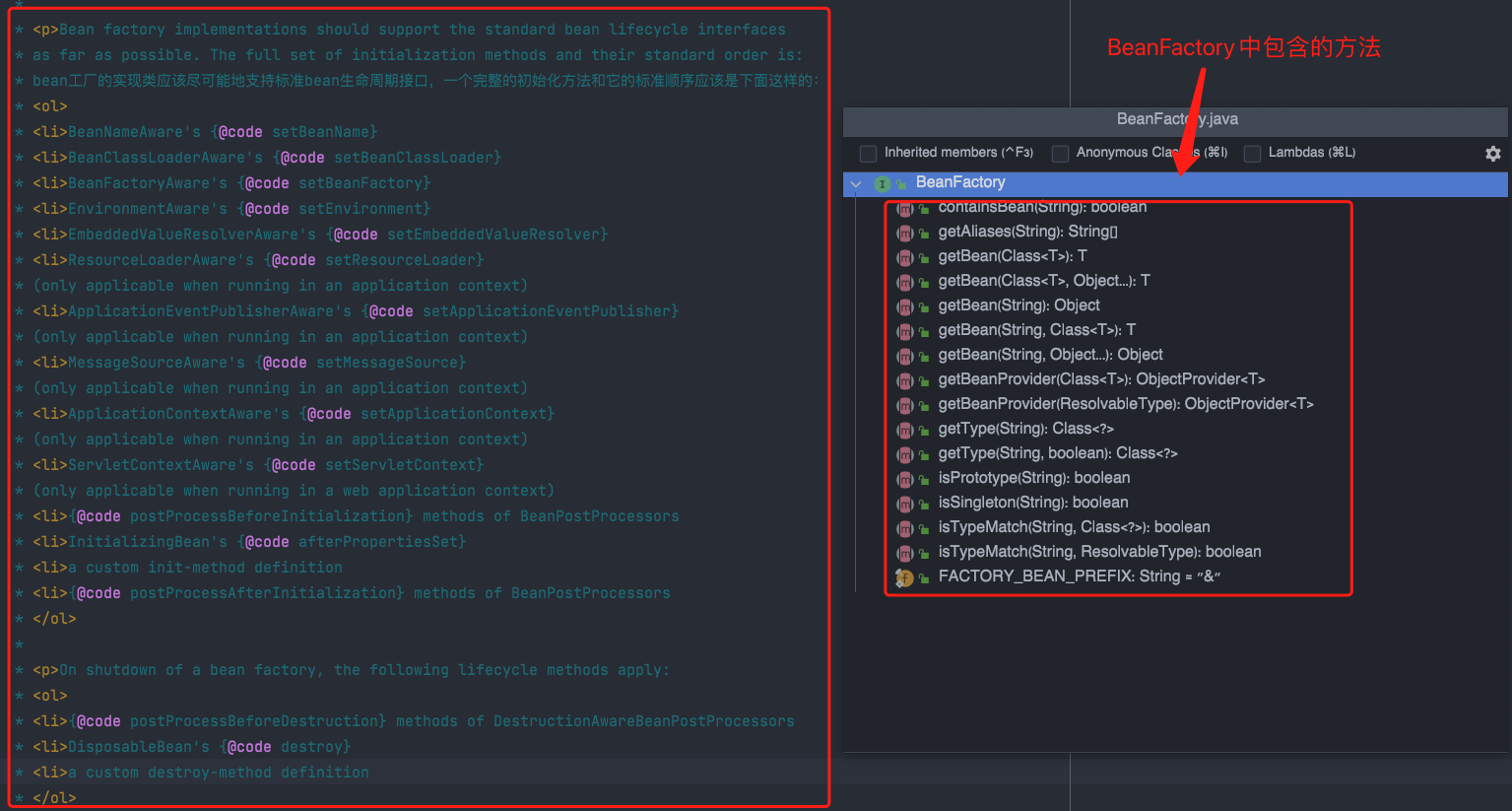
接下来看看每个阶段在容器内都发生了什么事情:
第一阶段:注册BeanDefinition

BeanDefinition是一个接口,继承了AttributeAccessor, BeanMetadataElement ,用来管理Bean的属性和元数据,管理的数据有属性、构造器、参数、是否单例、是否懒加载等这些我们平时定义的信息。在这个阶段,主要是扫描我们定义的Java类,定义的方式有基于XML和基于注解两种方式,将每个类的描述信息封装成一个BeanDefinition对象,注册到工厂中,生成一个beanName->BeanDefinition的映射关系,以便后续使用。
第二阶段:执行BeanFactoryPostProcessor
在BeanDefinition中有下面这样一段注释信息:
This is just a minimal interface: The main intention is to allow a BeanFactoryPostProcessor to introspect and modify property values and other bean metadata.
翻译过来意思就是说:BeanDefinition只是一个最小的接口,设计它的主要目的是为了让BeanFactoryPostProcessor内省并修改属性值和其他bean的元信息,所以执行BeanFactoryPostProcessor的主要目的就是可以通过自定义实现对bean定义信息的修改,比如修改属性等。其实这个接口是bean工厂的后置处理器,它的操作范围是整个工厂,通过实现该接口,我们可以获取到工厂中已经注册的所有bean的定义信息,并对任意信息进行修改,下面举个例子:
首先,定义一个bean
1 package com.spring.reading.bd.processor; 2 3 import lombok.AllArgsConstructor; 4 import lombok.Data; 5 import lombok.NoArgsConstructor; 6 import lombok.ToString; 7 import org.springframework.beans.factory.config.BeanDefinition; 8 import org.springframework.context.annotation.Scope; 9 import org.springframework.stereotype.Component; 10 11 /** 12 * @author: cyhua 13 * @createTime: 2021/12/6 14 * @description: 定义一个普通的bean,含有一个属性,scope手动设置原型 15 */ 16 @Data 17 @Component 18 @ToString 19 @NoArgsConstructor 20 @AllArgsConstructor 21 @Scope(value = BeanDefinition.SCOPE_PROTOTYPE) 22 public class Company { 23 24 private String name; 25 26 27 }
注意:上面的第21行代码,将scope自定义为原型,即多例,为了在BeanFactoryPostProcessor中对它进行修改!!!
其次,自定义一个BeanFactoryPostProcessor
1 package com.spring.reading.bd.processor; 2 3 import org.apache.commons.lang3.StringUtils; 4 import org.springframework.beans.BeansException; 5 import org.springframework.beans.factory.FactoryBean; 6 import org.springframework.beans.factory.config.BeanDefinition; 7 import org.springframework.beans.factory.config.BeanFactoryPostProcessor; 8 import org.springframework.beans.factory.config.ConfigurableListableBeanFactory; 9 import org.springframework.beans.factory.config.ConstructorArgumentValues; 10 import org.springframework.beans.factory.support.AbstractBeanDefinition; 11 import org.springframework.beans.factory.support.BeanDefinitionBuilder; 12 import org.springframework.stereotype.Component; 13 14 /** 15 * @author: cyhua 16 * @createTime: 2021/12/5 17 * @description: bean工厂后置处理器 18 */ 19 @Component 20 public class ReadingBeanFactoryPostProcessor implements BeanFactoryPostProcessor { 21 @Override 22 public void postProcessBeanFactory(ConfigurableListableBeanFactory configurableListableBeanFactory) throws BeansException { 23 AbstractBeanDefinition beanDefinition = (AbstractBeanDefinition) configurableListableBeanFactory.getBeanDefinition("company"); 24 //获取构造函数的参数值 25 ConstructorArgumentValues constructorArgumentValues = beanDefinition.getConstructorArgumentValues(); 26 //获取是否懒加载配置 27 Boolean lazyInit = beanDefinition.isLazyInit(); 28 //获取scope配置 29 String scope = beanDefinition.getScope(); 30 //获取注入模式配置:byName或byType 31 int autowireMode = beanDefinition.getAutowireMode(); 32 //scope如果为空或多例,则修改scope为单例 33 if (StringUtils.isBlank(scope) || scope.equals(BeanDefinition.SCOPE_PROTOTYPE)) { 34 beanDefinition.setScope(BeanDefinition.SCOPE_SINGLETON); 35 } 36 } 37 38 }
上面代码中获取了几个比较常见的BeanDefinition信息,最后当scope为空或者为多例时,修改为单例。
接下来,写一个测试类,获取两个Company对象,并进行比较
1 package com.spring.reading.bd.processor; 2 3 import org.springframework.context.annotation.AnnotationConfigApplicationContext; 4 5 /** 6 * @author: cyhua 7 * @createTime: 2021/12/5 8 * @description: 9 */ 10 public class BeanDefinitionCaller { 11 12 13 public static void main(String[] args) { 14 AnnotationConfigApplicationContext context = new AnnotationConfigApplicationContext(BeanDefinitionConfig.class); 15 Company company1 = context.getBean("company", Company.class); 16 Company company2 = context.getBean("company", Company.class); 17 //比较两个对象是否相同:按道理已经设置成单例,会返回true 18 System.out.println(company1 == company2); 19 } 20 }
上面15、16行代码通过相同的beanName获取了两次bean实例
下面进行debug,看看在BeanFactoryPostProcessor中是否能获取到bean定义信息?
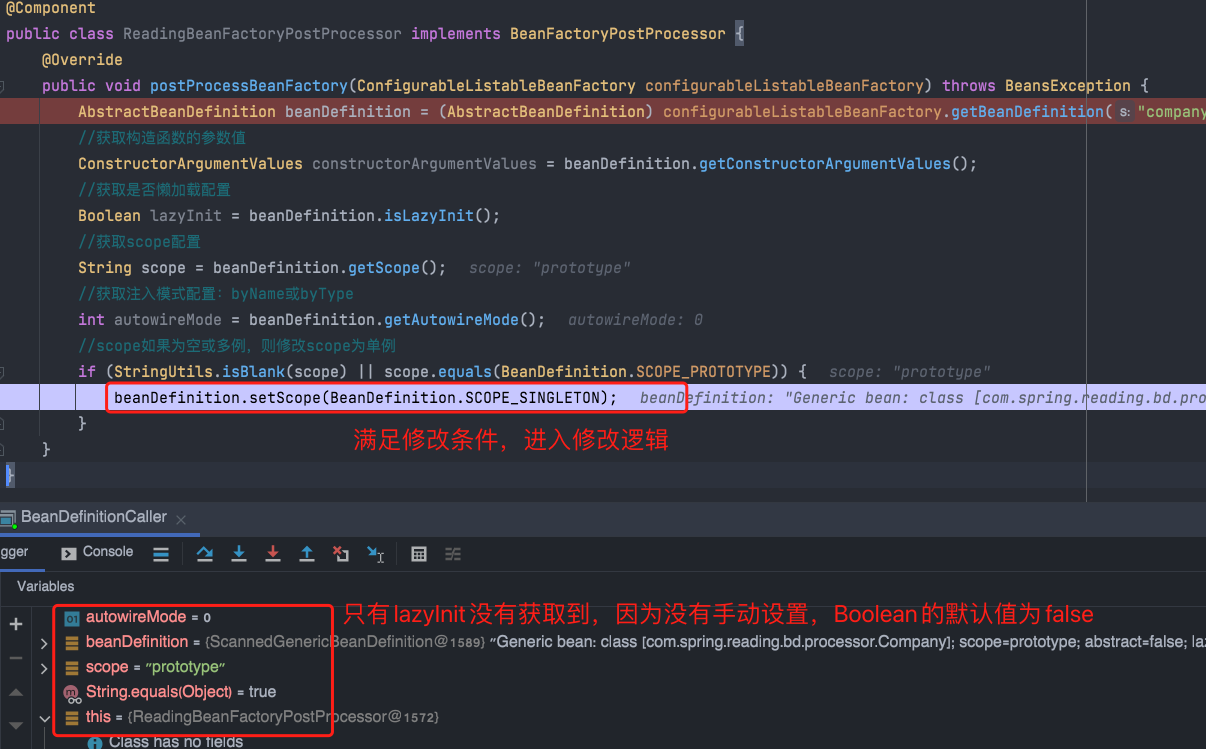
可以看当程序成功进入自定义的bean工厂后置处理器,也获取到了具体的BeanDefinition,下面看下执行结果:
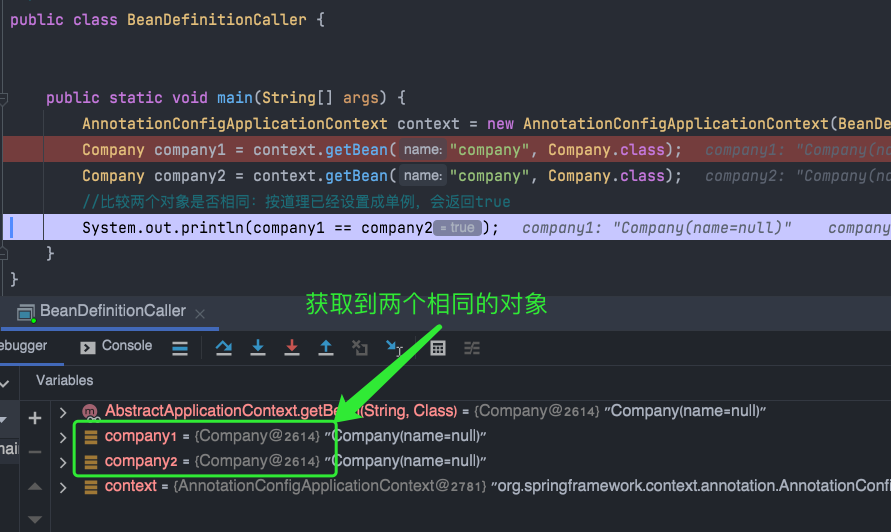
可以看到获取到了两个相同的对象,说明bean工厂后置处理器生效,修改bean定义成功,这就是执行BeanFactoryPostProcessor的作用,主要还是为了处理自定义的逻辑,方便开发者进行扩展,而且整个扩展过程完全满足OCP原则,忍不住想说一句:妙!
第三阶段:注册BeanPostProcessors、监听器等
第三个阶段主要还是准备一些后续需要的特殊bean,比如bean的后置处理器BeanPostProcessor、用户处理国际化的MessageSource、发布事件的广播器ApplicationEventMulticaster以及监听事件的监听器,下面针对这四种特殊的bean进行说明:
1.BeanPostProcessor
BeanPostProcessor就是一个接口,包含两个方法:
1 /** 2 * 在bean实例化之后,初始化之前使用,可以对返回对实例进行修改,比如修改属性值 3 * @param bean 要处理的bean实例 4 * @param beanName 要处理的bean名称 5 * @return 返回处理后的实例,默认返回传进来的实例 6 * @throws BeansException 7 */ 8 @Nullable 9 default Object postProcessBeforeInitialization(Object bean, String beanName) throws BeansException { 10 return bean; 11 } 12 13 /** 14 * 在bean初始化之后执行,可以对完成初始化的对象进行进一步的处理,比如生成代理对象,AOP中使用 15 * @param bean 要处理的bean 16 * @param beanName 要处理的bean名称 17 * @return 18 * @throws BeansException 返回处理后的实例,默认返回传进来的实例 19 */ 20 @Nullable 21 default Object postProcessAfterInitialization(Object bean, String beanName) throws BeansException { 22 return bean; 23 }
如注释所述,该接口提供了两个默认实现的方法,用于在初始化前后,对已经完成实例化的对象进行处理,虽然是接口,但是因为有了默认实现,开发时无需实现,但是可以通过自定义的后置处理器对bean进行特殊的处理,在AOP中,代理对象的生成就是利用了这里的postProcessAfterInitialization方法。
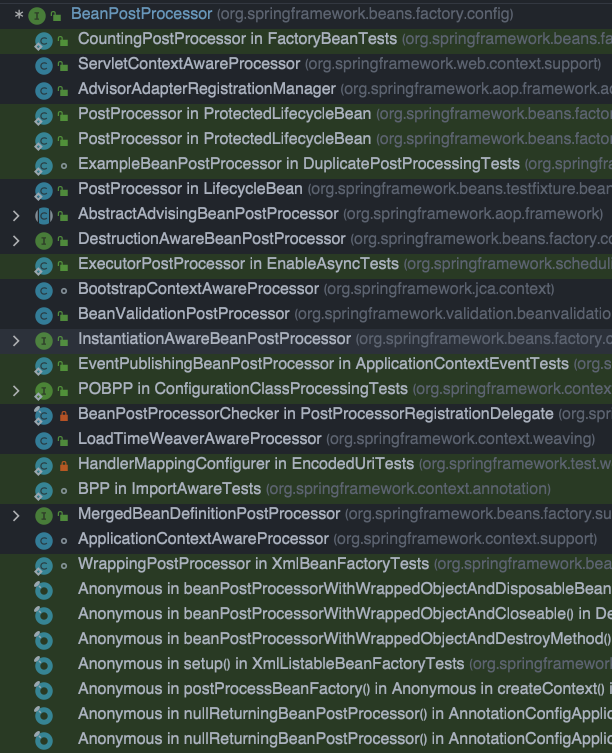
可以看到在spring中,已经又了很多该接口的实现类!
2.MessageSource
用于处理国际化的接口,源码中是这样描述的:
1 /** 2 * Strategy interface for resolving messages, with support for the parameterization 3 * and internationalization of such messages. 4 * 5 * <p>Spring provides two out-of-the-box implementations for production: 6 * <ul> 7 * <li>{@link org.springframework.context.support.ResourceBundleMessageSource}: built 8 * on top of the standard {@link java.util.ResourceBundle}, sharing its limitations. 9 * <li>{@link org.springframework.context.support.ReloadableResourceBundleMessageSource}: 10 * highly configurable, in particular with respect to reloading message definitions. 11 * </ul> 12 /
1、解析消息的策略接口,能够支持消息的参数化和国际化。
2、在Spring中提供了两个开箱即用的实现类:
一个构建在Java标准ResourceBundle之上的类ResourceBundleMessageSource
一个高度可配置的ReloadableResourceBundleMessageSource,值得一提的就是它能够重载消息定义
一般在支持国际化的项目中需要用到,知道有这么个接口即可!
3.ApplicationEventMulticaster
用户发布事件的接口,它的继承关系图如下:

有两个存在继承关系的实现类,这个在之前spring中的设计模式一文中有分析其源码,使用的是观察者模式,这里不再赘述。
4.ApplicationListener
有事件发布,就有事件监听,这个接口跟上面的广播器构成了观察者模式,用来处理spring中各种事件, 在设计模式中也讲过,这里不再赘述!
第四阶段:创建bean(实例化-初始化-放入容器)
下面来到第四个阶段,也是最重要、最复杂的一个阶段,前三个阶段都是在为这个阶段做准备的,在这个阶段,需要有一个意识:就是spring创建一个完整的对象需要经过三个大的步骤:
实例化-->属性填充-->初始化,而在初始化前后又可能会执行一些后置处理器
实例化阶段:只是在内存中开辟了一块空间,底层是通过bean定义信息推断出无参构造函数,然后选择合适的策略进行实例化,最后返回一个被Wrapper包装的实例,核心代码如下,一个位于BeanUtils类中的静态方法:
1 /** 2 * Convenience method to instantiate a class using the given constructor. 3 * <p>Note that this method tries to set the constructor accessible if given a 4 * non-accessible (that is, non-public) constructor, and supports Kotlin classes 5 * with optional parameters and default values. 6 * 使用给定的构造器调用实例化方法,需要注意的是,如果传递的是一个无访问全县的构造器,比如非public的,这个方法首先会尝试开启访问权限 7 *,而且通过可选参数支持Kotlin类和默认值 8 * @param ctor the constructor to instantiate 实例化构造器 9 * @param args the constructor arguments to apply (use {@code null} for an unspecified 构造器参数 10 * parameter, Kotlin optional parameters and Java primitive types are supported) 11 * @return the new instance 12 * @throws BeanInstantiationException if the bean cannot be instantiated 13 * @see Constructor#newInstance 14 */ 15 public static <T> T instantiateClass(Constructor<T> ctor, Object... args) throws BeanInstantiationException { 16 Assert.notNull(ctor, "Constructor must not be null"); 17 try { 18 //尝试将构造函数设置为可访问的 19 ReflectionUtils.makeAccessible(ctor); 20 if (KotlinDetector.isKotlinReflectPresent() && KotlinDetector.isKotlinType(ctor.getDeclaringClass())) { 21 return KotlinDelegate.instantiateClass(ctor, args); 22 } 23 else { 24 //获取构造器中的参数 25 Class<?>[] parameterTypes = ctor.getParameterTypes(); 26 //判断构造器中的参数个数是否比传进来的参数个数少,多则抛异常 27 Assert.isTrue(args.length <= parameterTypes.length, "Can't specify more arguments than constructor parameters"); 28 Object[] argsWithDefaultValues = new Object[args.length]; 29 //组装构造器的参数 30 for (int i = 0 ; i < args.length; i++) { 31 if (args[i] == null) { 32 Class<?> parameterType = parameterTypes[i]; 33 argsWithDefaultValues[i] = (parameterType.isPrimitive() ? DEFAULT_TYPE_VALUES.get(parameterType) : null); 34 } 35 else { 36 argsWithDefaultValues[i] = args[i]; 37 } 38 } 39 //通过构造方法创建一个bean实例 40 return ctor.newInstance(argsWithDefaultValues); 41 } 42 } 43 catch (InstantiationException ex) { 44 throw new BeanInstantiationException(ctor, "Is it an abstract class?", ex); 45 } 46 catch (IllegalAccessException ex) { 47 throw new BeanInstantiationException(ctor, "Is the constructor accessible?", ex); 48 } 49 catch (IllegalArgumentException ex) { 50 throw new BeanInstantiationException(ctor, "Illegal arguments for constructor", ex); 51 } 52 catch (InvocationTargetException ex) { 53 throw new BeanInstantiationException(ctor, "Constructor threw exception", ex.getTargetException()); 54 } 55 }
属性填充阶段:该阶段是在完成实例化之后,初始化之前执行的,填充属性,就是给属性赋值,比如数据库连接信息中有很多初始化值,就是在这个阶段进行填充
初始化阶段:该阶段是在完成实例化及属性填充之后执行的,而且在执行真正的初始化前后又要执行一些BeanPostProcessor的后置处理器,核心代码如下,调用AbstractAutowireCapableBeanFactory#initializeBean方法:
1 protected Object initializeBean(String beanName, Object bean, @Nullable RootBeanDefinition mbd) { 2 if (System.getSecurityManager() != null) { 3 AccessController.doPrivileged((PrivilegedAction<Object>) () -> { 4 invokeAwareMethods(beanName, bean); 5 return null; 6 }, getAccessControlContext()); 7 } 8 else { 9 //执行aware:回调实现了Aware接口的方法:设置beanName、classLoader、beanFactory等 10 invokeAwareMethods(beanName, bean); 11 } 12 13 //初始化之前执行 14 Object wrappedBean = bean; 15 if (mbd == null || !mbd.isSynthetic()) { 16 wrappedBean = applyBeanPostProcessorsBeforeInitialization(wrappedBean, beanName); 17 } 18 19 try { 20 //执行自定义初始化方法 21 invokeInitMethods(beanName, wrappedBean, mbd); 22 } 23 catch (Throwable ex) { 24 throw new BeanCreationException( 25 (mbd != null ? mbd.getResourceDescription() : null), 26 beanName, "Invocation of init method failed", ex); 27 } 28 //初始化之后执行 29 if (mbd == null || !mbd.isSynthetic()) { 30 wrappedBean = applyBeanPostProcessorsAfterInitialization(wrappedBean, beanName); 31 } 32 33 return wrappedBean; 34 }
第16行,会执行BeanPostProcessor的postProcessBeforeInitialization方法
第21行,会执行初始化方法,这个方法可以自定义,就是在bean定义是指定的init-method
第30行,会执行BeanPostProcessor的postProcessAfterInitialization方法
下面是完成最终初始化的核心代码,调用AbstractAutowireCapableBeanFactory#invokeInitMethods方法:
1 /** 2 * Give a bean a chance to react now all its properties are set, 3 * and a chance to know about its owning bean factory (this object). 4 * This means checking whether the bean implements InitializingBean or defines 5 * a custom init method, and invoking the necessary callback(s) if it does. 6 * 给bean一个反应它所有的属性都完成设置和了解它所属工厂的机会,这意味着不管bean实现了InitializingBean接口还是自定义了一个初始化方法,都会在这个地方被调用 7 * @param beanName the bean name in the factory (for debugging purposes) :bean在工厂中的名称 8 * @param bean the new bean instance we may need to initialize:准备去初始化的实例对象 9 * @param mbd the merged bean definition that the bean was created with 创建该bean的合并bean定义信息 10 * (can also be {@code null}, if given an existing bean instance) 11 * @throws Throwable if thrown by init methods or by the invocation process 12 * @see #invokeCustomInitMethod 13 */ 14 protected void invokeInitMethods(String beanName, Object bean, @Nullable RootBeanDefinition mbd) 15 throws Throwable { 16 17 //判断是否实现了InitializingBean接口,如果实现了就去执行afterPropertiesSet方法 18 boolean isInitializingBean = (bean instanceof InitializingBean); 19 if (isInitializingBean && (mbd == null || !mbd.isExternallyManagedInitMethod("afterPropertiesSet"))) { 20 if (logger.isTraceEnabled()) { 21 logger.trace("Invoking afterPropertiesSet() on bean with name '" + beanName + "'"); 22 } 23 if (System.getSecurityManager() != null) { 24 try { 25 AccessController.doPrivileged((PrivilegedExceptionAction<Object>) () -> { 26 ((InitializingBean) bean).afterPropertiesSet(); 27 return null; 28 }, getAccessControlContext()); 29 } 30 catch (PrivilegedActionException pae) { 31 throw pae.getException(); 32 } 33 } 34 else { 35 ((InitializingBean) bean).afterPropertiesSet(); 36 } 37 } 38 39 //执行自定义的初始化方法 40 if (mbd != null && bean.getClass() != NullBean.class) { 41 String initMethodName = mbd.getInitMethodName(); 42 if (StringUtils.hasLength(initMethodName) && 43 !(isInitializingBean && "afterPropertiesSet".equals(initMethodName)) && 44 !mbd.isExternallyManagedInitMethod(initMethodName)) { 45 invokeCustomInitMethod(beanName, bean, mbd); 46 } 47 } 48 }
如注释所述,初始化其实就是调用用户自定义的init-method方法和afterPropertiesSet方法!
第五阶段:管理生命周期、发布刷新事件
这是最后一个阶段,应该说是容器启动过程,或容器实例化过程中的最后一个阶段,因为完整的过程中最后应该是要执行bean的销毁。
这个阶段主要就是给上下文设置生命周期处理器,以管理这个上下文中bean的生命周期,如果工厂中有,就直接赋值,工厂中没有,就new一个再赋值,核心代码如下,AbstractApplicationContext#initLifecycleProcessor方法:
1 /** 2 * Initialize the LifecycleProcessor. 3 * Uses DefaultLifecycleProcessor if none defined in the context. 4 * 5 * @see org.springframework.context.support.DefaultLifecycleProcessor 6 */ 7 protected void initLifecycleProcessor() { 8 ConfigurableListableBeanFactory beanFactory = getBeanFactory(); 9 if (beanFactory.containsLocalBean(LIFECYCLE_PROCESSOR_BEAN_NAME)) { 10 this.lifecycleProcessor = 11 beanFactory.getBean(LIFECYCLE_PROCESSOR_BEAN_NAME, LifecycleProcessor.class); 12 if (logger.isTraceEnabled()) { 13 logger.trace("Using LifecycleProcessor [" + this.lifecycleProcessor + "]"); 14 } 15 } else { 16 DefaultLifecycleProcessor defaultProcessor = new DefaultLifecycleProcessor(); 17 defaultProcessor.setBeanFactory(beanFactory); 18 this.lifecycleProcessor = defaultProcessor; 19 beanFactory.registerSingleton(LIFECYCLE_PROCESSOR_BEAN_NAME, this.lifecycleProcessor); 20 if (logger.isTraceEnabled()) { 21 logger.trace("No '" + LIFECYCLE_PROCESSOR_BEAN_NAME + "' bean, using " + 22 "[" + this.lifecycleProcessor.getClass().getSimpleName() + "]"); 23 } 24 } 25 }
然后将上下文刷新事件通过第三阶段注册的广播器进行广播,在广播方法中,实际调用的是监听器的方法,核心代码如下:
1 protected void publishEvent(Object event, @Nullable ResolvableType eventType) { 2 Assert.notNull(event, "Event must not be null"); 3 4 // Decorate event as an ApplicationEvent if necessary 5 ApplicationEvent applicationEvent; 6 if (event instanceof ApplicationEvent) { 7 applicationEvent = (ApplicationEvent) event; 8 } else { 9 applicationEvent = new PayloadApplicationEvent<>(this, event); 10 if (eventType == null) { 11 eventType = ((PayloadApplicationEvent<?>) applicationEvent).getResolvableType(); 12 } 13 } 14 15 // Multicast right now if possible - or lazily once the multicaster is initialized 16 if (this.earlyApplicationEvents != null) { 17 this.earlyApplicationEvents.add(applicationEvent); 18 } else { 19 getApplicationEventMulticaster().multicastEvent(applicationEvent, eventType); 20 } 21 22 // Publish event via parent context as well... 23 if (this.parent != null) { 24 if (this.parent instanceof AbstractApplicationContext) { 25 ((AbstractApplicationContext) this.parent).publishEvent(event, eventType); 26 } else { 27 this.parent.publishEvent(event); 28 } 29 } 30 }
第19行,获取广播器并广播事件,广播事件接口会传事件和事件类型:
1 public void multicastEvent(final ApplicationEvent event, @Nullable ResolvableType eventType) { 2 //第一步:调用resolveDefaultEventType方法解析事件的类型,会返回类的全限定名 3 ResolvableType type = (eventType != null ? eventType : resolveDefaultEventType(event)); 4 Executor executor = getTaskExecutor(); 5 //根据事件和事件类型获取监听器 6 for (ApplicationListener<?> listener : getApplicationListeners(event, type)) { 7 if (executor != null) { 8 //异步执行监听任务 9 executor.execute(() -> invokeListener(listener, event)); 10 } 11 else if (this.applicationStartup != null) { 12 StartupStep invocationStep = this.applicationStartup.start("spring.event.invoke-listener"); 13 invokeListener(listener, event); 14 invocationStep.tag("event", event::toString); 15 if (eventType != null) { 16 invocationStep.tag("eventType", eventType::toString); 17 } 18 invocationStep.tag("listener", listener::toString); 19 invocationStep.end(); 20 } 21 else { 22 //将事件event通知给监听器listener 23 invokeListener(listener, event); 24 } 25 } 26 }
如上代码所示,通过invokeListener(listener, event)完成了事件的监听,具体的逻辑就交给具体的监听器处理了。
到此为止,spring的设计思想梳理的也差不多了,知道了这些,就会对spring有一个更加具体的整体把控了,可能有些地方描述的不够清楚,都是凭自己的理解写的,仅供参考,我也会继续向前深入研究,向后回头反思!
本文来自博客园,作者:bug改了我,转载请注明原文链接:https://www.cnblogs.com/hellowhy/p/15638373.html



